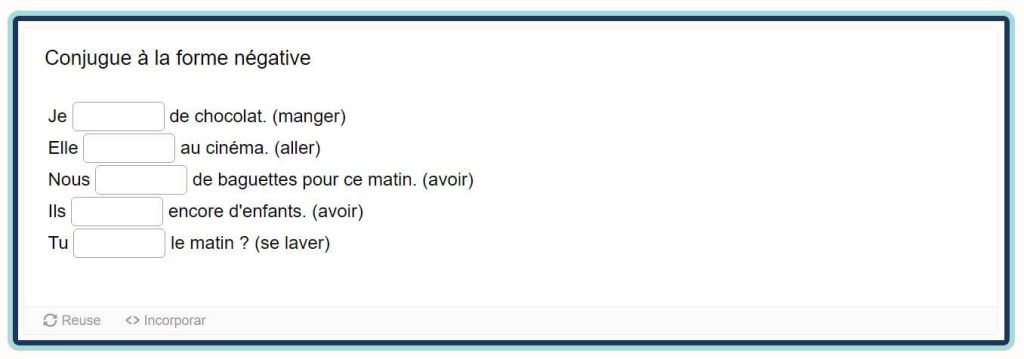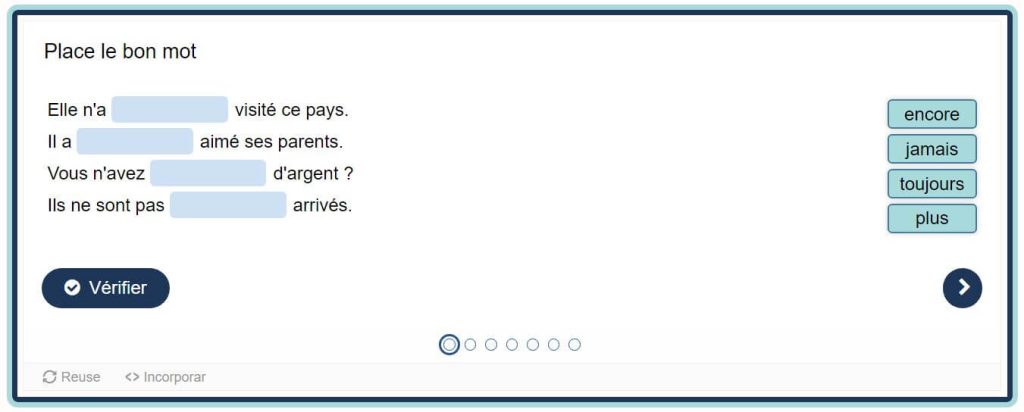Negation is not particularly difficult in French, but there are some rules that should be remembered. However, it becomes more complicated with passé composé. Let’s take a look together!
The basic rules of negation in French
The negation in French in the present tense has the following basic structure:
➠ SUBJECT + NE + VERB + PAS
➠ SUBJECT + N’ (élision) + VERB + PAS
Examples:
– Je n’aime pas le poisson (I don’t like fish)
– Il ne commence pas encore la leçon (He hasn’t started the lesson yet)
– Nous ne cuisinons pas le soir (We don’t cook in the evening)
Negation with pronominal verbs
Negation with pronominal verbs in the compound past tense follows a similar structure to that of non-pronominal verbs. But don’t forget to put the reflexive pronoun between the negation loop:
- Je ne me lève pas tôt les dimanches. (I don’t get up early on Sundays)
- Nous ne nous sommes pas lavés se matin. (We didn’t wash this morning.)
Attention: In the negative form, we replace un, une, des with de (or d’).
– Je n’ai pas de pull / j’ai un pull
– Nous n’avons pas de chien / j’ai un chien
– Il n’a pas de chance / il a de la chance
Indefinite articles have yet another peculiarity. “Des” becomes “de” when there is an adjective between the article and name.
– J’ai des yeux bleus. (I have blue eyes).
– J’ai de beaux yeux. (I have beautiful eyes).
Un exercice facile !
Register for free to do the exercises and access +1000 exercises and videos in French.

Other forms of negation in French
Ne…pas can often be combined with an adverb to create a more specific negative expression.
| ne…pas du tout | Je n’aime pas du tout ta femme. | not at all |
| ne…pas encore | Tu n’as pas encore terminé ? | not yet |
| ne…pas non plus | Elle ne va pas non plus commencer. | neither |
| ne…pas toujours | Vous n’avez pas toujours raison ! | not always |
In addition to PAS there are other forms of negation.
You can use:
- RIEN (nothing) : Je ne veux rien faire (I don’t want to do anything)
- JAMAIS (never) : Je ne vais jamais chez le dentiste (I never go to the dentist)
- PLUS (anymore) : Je ne travaille plus là (I don’t work there anymore)
- AUCUN/ AUCUNE (none) : Il n’a aucune chance (He has no chance)
- PERSONNE (nobody / anyone) : Je ne connais personne (I don’t know anyone)
The following parts are for a more advanced level
Negation in passé composé in French
The basic form of French negation is simple when it is in the present tense. In general it complicates when we are answering a question in the past (passé composé) and using a direct verb complement (COD).
The negation in the passé composé in French is formed by using the auxiliary “avoir” or “être” conjugated in the present tense, followed by the past participle of the verb, and placing “ne” before the auxiliary and “pas” after the past participle.
Exemples :
- Je n’ai pas trouvé la poste. I could not find the post office.
- Nous n’avons pas choisi le dessert. We did not choose dessert.
- Vous n’avez toujours pas fini ? Aren’t you done yet?
La négation avec les verbes pronominaux au passé
Remember that for a passé composé sentence, the negation “ne…pas” is placed before and after the conjugated auxiliary verb (in the “sandwich”). Attention it is the auxiliary (être or avoir) that is important here (which is what is in the sandwich) and not the past participle verb!
We keep this same rule for pronominal verbs, but in the sandwich we will add a layer: the reflexive pronoun.
Exemples :
- Je ne me suis pas brossé les dents ce matin.
- Nous ne nous sommes pas étonnés de sa vitesse.
- Elle ne s’est pas rappelée de moi.
Too much information? Don’t worry, take your time, save this article for another time and practice as much as you can.
Maintenant à toi !
Register for free to do the exercises and access +1000 exercises and videos in French.





